Is My Garden Soil Ok Even Tho Rocks Keep Coming To The Surface
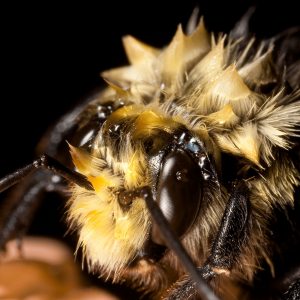 I'm often asked by folks what to do when one finds a cold, wet, or sluggish bee. The good news is that in many cases, you can help! And depending on the bee, you may not just be helping one bee but many, because your bee may be a queen bee.
I'm often asked by folks what to do when one finds a cold, wet, or sluggish bee. The good news is that in many cases, you can help! And depending on the bee, you may not just be helping one bee but many, because your bee may be a queen bee.
If after reading all of the tips and advice below, you still have questions about your particular bee situation, drop your question on this page and I'll try to get back to you as soon as I possibly can!
Spring and fall are often unpredictable weather and flower-wise, and sometimes you'll find a bee who's simply run out of steam and needs a helping hand. Unseasonable weather and a lack of flowers may trip them up, especially at these times of year. A foraging bumble bee is only ever about 40 minutes from starvation.
Late fall bumble bee queens
In late fall, large young bumble bee queens are seeking the last good flowers, stocking up their energy and fat reserves in preparation for hibernation. They're also searching for nice spots in the ground, in which they'll overwinter. They often dig their own small burrows in which to hibernate (behavior you'll sometimes see if you're in the right place at the right time!)
Sometimes they'll appreciate a little help, especially if they're nearly out of energy. Since they're relatively large bees, they need more energy simply to get off the ground. Try offering sugar water, moving them somewhere warmer (into direct sunlight, ideally), or even warming them up a bit gently with your breath.
Late fall male bumble bees
In late fall, you'll sometimes find congregations of small fluffy bumble bees spending the nights on late-season flowers (it's a great time to photograph them, as they can't move about much until they warm up!)
There's no need to worry about these bumble bees. They'll all "buzz up" again as soon as the day warms (and they're totally willing to spend several days out on the flowers, even in the rain if need bee). Once they warm up, they have breakfast right at hand, nectar within the flowers to which they've been clinging. And it's worth their wait, as warm days bring young bumble bee queens to the flowers on which they've been sleeping!
Early spring bumble bee queens
In early spring, large fluffy bumble bee queens are emerging from their winter hibernation. They're searching for the earliest spring flowers and looking for the perfect underground burrow in which to start their colonies for the year (colonies that will number in the low hundreds of cute, fuzzy bumble bees).
A quick sugar-water fix
Quick Recipe
- 1 part sugar crystals (not brown)
- 1 part room temperature water
Mix vigorously, then offer small portion
The first thing to do is to feed your bee. A cold, hungry bee is nothing to fear (in fact, bees are nothing to fear anyway, and you're probably not too worried if you're reading this page… but if you are, keep in mind that a cold sluggish bee is in no position or mood to sting… they're simply hungry and cold, and will be happy for any help you provide).
To feed your bee, mix up some organic granulated cane sugar or refined white sugar crystals to create a sugar-water solution. A 1:1 mix (50%/50%) is appropriate, and this can be achieved simply by stirring the sugar rapidly in room temperature water. Offer a small portion of this solution (just a drop or two to begin with) in a shallow lid or teaspoon placed near the bee's head.
When drinking, you'll see her long tongue (sometimes almost as long as her body) pointing down from her head. If you see her tongue extended, try placing drops of sugar-water mix directly beneath the tip (it functions like a straw). Not too much as a weakened bee may be clumsy, and you don't want to make the situation worse by getting your bee covered in sugary water (which a sluggish bee may have trouble cleaning off, though she'll be able to once she recovers her energy).
In most cases, your bee will recover quickly after drinking some sugar-water. Offering sugar-water often works even if it appears to you as though your bee is dead! A quick sugar-water fix should help your bee on its way to living another day 😌 It may take a few minutes or a few hours for her to recover, depending on how weak she was to begin with. Don't be surprised to find your bee gone if you're not keeping a constant eye on her!
Note that if it's cold out (but otherwise good weather for bees), you'll speed your bee's recovery by warming her up. You may do this by placing her in direct sunlight, by letting her sit on your warm skin (a hand or arm), or by bringing her indoors briefly (in a ventilated box) to warm up and drink some sugar-water.
If it's not looking like good bee-flying weather, or if it's getting late and the sun is setting, you may want to consider housing your bee overnight to protect her from predators while she is in a vulnerable state.
Shared with kind permission by reader Christine
Types of sugar to avoid
It's important to avoid brown sugar (which contains extra solids from molasses) and avoid maple syrup (which contains extra minerals), both of which are difficult for bees to digest. Also, do not use boiling water (when sugars caramelize at high heat, they can create indigestible and possibly bee-toxic compounds).
In years past, I advised feeding a drop of local raw honey, but this can be a vector for spreading bee diseases, so to be safe, avoid feeding honey. If you've fed honey in the past, don't worry about it too much, chances are you likely helped anyway.
Avoid high fructose corn syrup at all costs, as compounds toxic to bees can be formed during manufacturing (as a result of overheating). And it should go without saying to avoid the fake stuff! I avoid conventional sugar because of possible pesticide residues (especially when sourced from sugar beets, which account for most sugar production and consumption in the United States; Monsanto licenses a Roundup Ready trait to sugarbeet seed companies).
Feeding bees sugar-water
The sugar-water solution I detail above should only be used in emergency situations. Sugar-water is not sufficient for bees' nutritional needs long-term (they need all the other trace components of flower nectar for a balanced diet). Putting a dish of sugar-water out may attract bees, but it is not a good idea and it will not help bees in your area, however much they may appear to appreciate it as free food (it can also incense some bees and cause them to be more aggressive than they usually would be, as they compete for such an unusually easy food source).
Bees need pure water though! One of the best things you can do (especially on hot days) is to provide a large shallow dish of fresh water with pebbles in it so that bees may easily reach the water without falling into it. Honey bees in particular need water on hot days in order to cool their hives, and you may see a variety of pollinators and other insects coming to your water dish if you watch for any length of time!

Honey bee illustrating reddish tongue, by Ethan Kocak
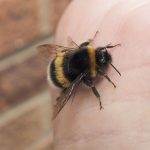
John's story of the 'Bee that Stayed'
Reader John first wrote to me in reply to my post about how to revive a cold, wet, or exhausted bee. In his words: "I can't believe this, I love Bumble Bees, and when I find one in the garden lying there exhausted, I mix a bit of sugar with water and let them crawl on my hand have a drink, then they sleep for 3 minutes and fly off revitalized. Well. I found one lying on the lawn in a bad state, so I did my usual, NOW he has stayed on my hand and won't go away, he stayed there whilst I mowed the lawn, and he is still here 1 hour later, he has stayed on my finger whilst I am typing, so I put him on a piece of kitchen roll next to me on the table." Read more
What if it's cold or raining outdoors, or the sun has almost set?
Sometimes you'll find a bee in need of help in unseasonable weather (especially in early spring when bumble bee queens are emerging from hibernation). After offering sugar-water, you may decide that the best thing to do is to keep your bee safe overnight. If it's late at night and cold, or raining or even snowing outdoors, then releasing your bee may not be an option.
Base your decision on the time of day, the weather, and your observation of the bee… if it's morning or afternoon, and she looks ready to go after sipping sugar-water, then she'll likely want to bee on her way (even if it's cool and a bit rainy). If it's approaching evening or night, the weather is worsening, and the bee seems sluggish, her chances will improve by keeping her overnight (some people even end up keeping their bees several nights in a row, until the weather improves… just be sure to mimic as much as possible typical day/night light cycles and temperatures, so your bee doesn't get confused).
In this case, it's time to make a cozy home for your bee for the night. A shoebox works well for this (with small holes punched in it to provide ventilation). Although we like soft things to lie on, it's best not to add materials inside the box, as things like fabric may catch on a sluggish bee's feet and make moving even more of a struggle for her.
Place her in the box, and provide a little greenery too so that it's not just a bee inside a stark, empty box. Generally speaking (for overnight stays), I'd avoid placing flowers in the box, as they will lose their nectar fairly quickly, and may confuse a bee looking for food. However, I've heard of times when having flowers inside the box is just the thing to "cheer up" a bee and speed her on her way. If the time of day and weather is just "iffy" and might still be good enough for your bee to go out in, then try adding flowers into her box and seeing if she buzzes around sufficiently to bee on her way. If you're still left with a sluggish bee, remove the flowers but put something natural of interest in the box for the night.
Place the box somewhere that's not too warm and not too cold… err on the side of cooler, simply because it's going to simulate their natural environment better. But certainly don't allow the box to sit in freezing temperatures! Somewhere "in-between" such as a garage, utility room, or other sheltered and lightly-heated area is ideal. I'd recommend removing any dish of sugar-water overnight, so as not to attract ants or risk the bee falling in. You can put it back again in the morning.
Gorgeous red-tailed bumble bee queen shared with kind permission by reader Emily
Check on your bee from time to time; if she's full of energy and buzzing, she may well wish to take her chances outdoors. Bumble bee queens in particular are fairly well-equipped for unseasonable weather. Bumble bees are quite special in terms of their ability to decouple their flight muscles from their wings and vibrate (or "shiver") in order to warm themselves up.
If your bee seems comfortable and settled in her box, then wait to release her until the weather is more favorable (at least 50-55°F or 10-12°C). Bees are not particularly early risers! On the next day of decent weather, make sure your bee has had a little sugar-water for breakfast, and then leave her box open in a sunny warm spot outdoors. Release your bee near where you found her, ideally near flowers where you see other similar bees foraging. It can take anywhere between minutes and hours for her to feel ready to leave. If you hang around watching for a little while, you'll likely see her buzz around her box a bit first, before finally taking off happily!
A few years ago I read the most charming story about someone's encounter with a bumble bee queen and how she rescued it with sugar water and a night in a shoebox. Read her inspiring story on the Bumblebee Conservation Trust website:
The Plight of the Bumblebee
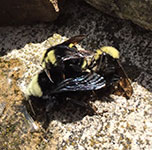
Hosting tiny guests at an Air Bee-n-Bee in San Francisco
Today I heard from Ann in San Francisco with a question after she found my post about how to revive a cold, wet, or exhausted bee. Astonishingly, a queen bumble bee—carrying three little worker bees, no less!—had sought out Ann's help in the garden. In her words: "Hi, I have a queen bee that visited my back patio yesterday and she kept following me around and trying to get under a bag of potting soil…I moved the bag and then her…to under a sunny bush…she was then crawling back to me! So I put down my glove and she hopped on and I found a more protected area of the lawn where she spent the night. Today she is back with three small bumble bees on her back she is not moving and will not drink its going to get cold and windy soon…what do I do???" Read more
How to save a drowning bee
Sometimes people see bees struggling in water, unable to reach anything that would give them a "leg up" and out to safety. The easiest way to rescue a bee from water is to use a leaf or some other object close-to-hand to scoop them up. If you rescue your bee from water, the first thing to do is to put her in the sunlight so she can dry out and warm up. While we generally prefer recovering in the shade, bees recover far faster in full sun.
Avoid handling the bee much, or attempting to separate the wings or correct other things that appear amiss. Warm sun will help "reactivate" the bee, after which she can clean herself (if she needs) much more gently and effectively than us. It's also a good idea to offer a few drops of sugar-water mix as above, if your bee doesn't take off soon after being scooped up and drying off somewhere warm.
If it's too late at night for there to be any warmth or sunlight, then keep your bee overnight in a ventilated box following the suggestions above, and release her the following morning.
What if there are mites on the bee?
The bee mites we read about in the news are a very specific type of mite (Varroa destructor) that only affects honey bees because of their unique life cycle. If your bee is a larger, fuzzier bee, chances are it has harmless bumble bee mites instead. Bumble bees often have mites… they're just far smaller mites, and they're not dangerous for the bee. They're typically "hitchhiking" to the bumble bee's nest from flowers, where the mites then feed on small bits of detritus around the nest.
So there's no need to try to remove tiny mites from bees you find. The only time they can be a problem is in rare instances when hundreds pile onto a bee at once, impacting its ability to fly. I've seen photos documenting this, but it really is unusual. Honey bee mites are far larger by comparison… it would be like one of us having a rabbit-sized tick feeding off us!
What if I'm out and about and find a struggling bee?
When I go for long walks in spring, I carry a small vial of sugar-water with me in case I see a struggling bee in need. This way I can drop a few droplets onto something like a leaf or flower (right below the bee's head), in order to give it a top-up of energy. If you don't have sugar water with you, you might instead try gently moving your bee (using a leaf or similar) onto nearby flowers where you (ideally) see other, similar bees foraging.
And if you'd love to carry sugar water with you at all times just in case you find a bee in need, I've discovered the neatest solution, complete with protective keychain carrying case for the glass vial! Although UK-based, they'll ship elsewhere too:
Beevive, inspired by a spontaneous encounter with a tired bee
What kind of bee is it?
There are so many different kinds of bees, but when you find a bee, it's very often one of the more common types. If it's large and fuzzy, it's probably a bumble bee. If it'sreally large and fuzzy, it's probably a queen bumble bee (especially if it's early spring). Honey bees are smaller by comparison, less fuzzy, and have that classic "striping" that we expect from seeing drawings of bees.
Honey bees need to get back to their hives for the night, but bumble bees can stay out a night or two just fine. Bumble bees are also capable of generating their own heat (which they do by decoupling their wings from their flight muscles and then "buzzing" to warm up)! Bumble bees are more likely to get caught out in bad weather, simply because they're more likely to fly in cooler temperatures (even in the rain), whereas honey bees stay tucked in their hives on cold and rainy days.
So if you find a bee on a cold, wet day, it's most likely a bumble bee. You can help a bumble bee by offering sugar-water and potentially keeping the bee overnight in a ventilated box (as above), especially if it's late in the day and the weather is worsening. Release your bee the following morning once the sun is up, and offer sugar-water again to give the bee an energetic start to her day!
Honey bees are most often found in need of help when they've fallen into a pool of water on a warm day. Honey bees collect water in order to cool their hives, hence they face more dangers from falling into pools and ponds while trying to get to the water. Honey bees can be helped by simply removing them from the water and putting them in the sun (offering sugar-water helps too, especially if your bee almost drowned before you found her). If you consistently find yourself rescuing bees from pools of water near your home, try placing pebbles in a shallow dish of water nearby to provide them a safer place to drink, especially on hot days!
These are all bumble bee queens:
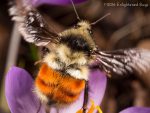
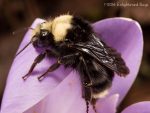
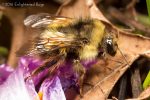
These are all honey bee workers:
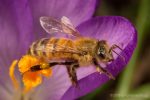
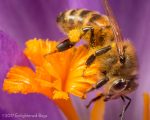
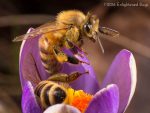
All the Buzz!
 An occasional email newsletter from Elise Fog (bee enthusiast), including gardening advice for particular times in the bee season, as well as discussion of curious bee facts, current scientific bee research, and other such bee-related goodness.
An occasional email newsletter from Elise Fog (bee enthusiast), including gardening advice for particular times in the bee season, as well as discussion of curious bee facts, current scientific bee research, and other such bee-related goodness.
I only use your email address to send you occasional bee-related emails (opt-out any time). Read my full privacy policy.
A short note from Elise Fog
![]()
Hello, I hope your bee is feeling better! If you're still concerned, do drop your question below and I'll try to answer as quickly as I can. The response to this page has been incredible, and I've added to this page based on hearing so many bee stories.
I truly believe every single bee's life counts. I also think that saving a bee's life creates a special connection that will never bee forgotten. Sir David Attenborough once said something along the lines of: if you love something, you'll care about saving it, but you won't fall in love until you've seen and learned about it first.
If you find this website valuable, I'd so appreciate it if you consider supporting this project. One way is to support my bee art 🐝 Another way is with a one-time or monthly contribution 💛
Update: I am so sorry to all those who dropped bee questions here in the last year or so, that went unanswered by me. This has been such a hard time for many, and it is with much sadness that I report losing my home and bee meadow project to the Holiday Farm Fire on the night of Labor Day 2020. Climate change is real, and so destructive. We must act quickly as a species to mitigate the worst of the damage.
Is My Garden Soil Ok Even Tho Rocks Keep Coming To The Surface
Source: https://savebees.org/how-to-help-revive-a-cold-or-wet-bee/
Posted by: peoplessyrument82.blogspot.com

0 Response to "Is My Garden Soil Ok Even Tho Rocks Keep Coming To The Surface"
Post a Comment